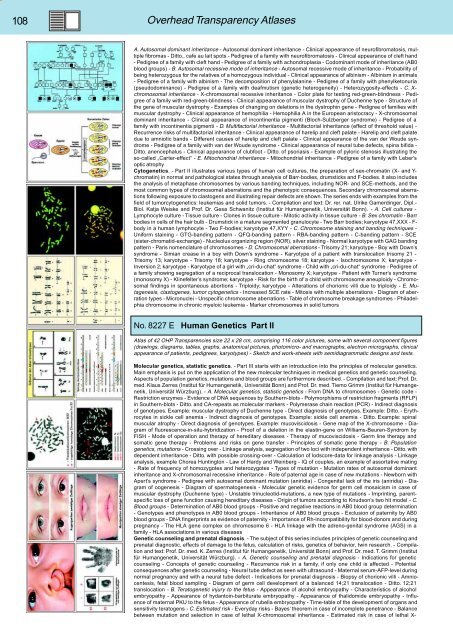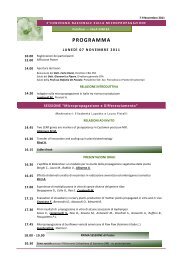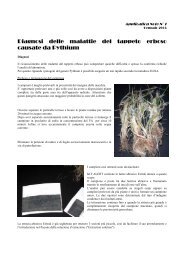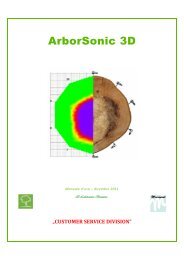BIOLOGY - microscopia.info
BIOLOGY - microscopia.info
BIOLOGY - microscopia.info
You also want an ePaper? Increase the reach of your titles
YUMPU automatically turns print PDFs into web optimized ePapers that Google loves.
108<br />
Overhead Transparency Atlases<br />
A. Autosomal dominant inheritance - Autosomal dominant inheritance - Clinical appearance of neurofibromatosis, multiple<br />
fibromas - Ditto., cafe au lait spots - Pedigree of a family with neurofibromatosis - Clinical appearance of cleft hand<br />
- Pedigree of a family with cleft hand - Pedigree of a family with achondroplasia - Codominant mode of inheritance (AB0<br />
blood groups) - B. Autosomal recessive mode of inheritance - Autosomal recessive mode of inheritance - Probability of<br />
being heterozygous for the relatives of a homozygous individual - Clinical appearance of albinism - Albinism in animals<br />
- Pedigree of a family with albinism - The decomposition of phenylalanine - Pedigree of a family with phenylketonuria<br />
(pseudodominance) - Pedigree of a family with deafmutism (genetic heterogeneity) - Heterozygosity-effects - C. X-<br />
chromosomal inheritance - X-chromosomal recessive inheritance - Color plate for testing red-green-blindness - Pedigree<br />
of a family with red-green-blindness - Clinical appearance of muscular dystrophy of Duchenne type - Structure of<br />
the gene of muscular dystrophy - Examples of changing on deletions in the dystrophin gene - Pedigree of families with<br />
muscular dystrophy - Clinical appearance of hemophilia - Hemophilia A in the European aristocracy - X-chromosomal<br />
dominant inheritance - Clinical appearance of incontinentia pigmenti (Bloch-Sulzberger syndrome) - Pedigree of a<br />
family with incontinentia pigmenti - D. Multifactorial inheritance - Multifactorial inheritance (effect of threshold value) -<br />
Recurrence risks of multifactorial inheritance - Clinical appearance of harelip and cleft palate - Harelip and cleft palate<br />
due to amniotic bands - Different causes of harelip and cleft palate - Clinical appearance of the van der Woude syndrome<br />
- Pedigree of a family with van der Woude syndrome - Clinical appearance of neural tube defects, spina bifida -<br />
Ditto. anencephalus - Clinical appearance of clubfoot - Ditto. of psoriasis - Example of pyloric stenosis illustrating the<br />
so-called „Carter-effect“ - E. Mitochondrial inheritance - Mitochondrial inheritance - Pedigree of a family with Leber’s<br />
optic atrophy<br />
Cytogenetics. - Part II illustrates various types of human cell cultures, the preparation of sex-chromatin (X- and Y-<br />
chromatin) in normal and pathological states through analysis of Barr-bodies, drumsticks and F-bodies. It also includes<br />
the analysis of metaphase chromosomes by various banding techniques, including NOR- and SCE-methods, and the<br />
most common types of chromosomal aberrations and the phenotypic consequences. Secondary chromosomal aberrations<br />
following exposure to clastogens and illustrating repair defects are shown. The series ends with examples from the<br />
field of tumorcytogenetics: leukemias and solid tumors. - Compilation and text: Dr. rer. nat. Ulrike Gamerdinger, Dipl.-<br />
Biol. Katja Weiske and Prof. Dr. Gesa Schwanitz (Institut für Humangenetik, Universität Bonn). - A. Cell cultures -<br />
Lymphocyte culture - Tissue culture - Clones in tissue culture - Mitotic activity in tissue culture - B. Sex chromatin - Barr<br />
bodies in cells of the hair bulb - Drumstick in a mature segmented granulocyte - Two Barr bodies; karyotype 47,XXX - F-<br />
body in a human lymphocyte - Two F-bodies; karyotype 47,XYY - C. Chromosome staining and banding techniques -<br />
Uniform staining - GTG-banding pattern - QFQ-banding pattern - RBA-banding pattern - C-banding pattern - SCE<br />
(sister-chromatid-exchange) - Nucleolus organizing region (NOR), silver staining - Normal karyotype with GAG banding<br />
pattern - Paris nomenclature of chromosomes - D. Chromosomal aberrations - Trisomy 21; karyotype - Boy with Down’s<br />
syndrome - Simian crease in a boy with Down’s syndrome - Karyotype of a patient with translocation trisomy 21 -<br />
Trisomy 13; karyotype - Trisomy 18; karyotype - Ring chromosome 18; karyotype - Isochromosome X; karyotype -<br />
Inversion 2; karyotype - Karyotype of a girl with „cri-du-chat“ syndrome - Child with „cri-du-chat“ syndrome - Pedigree of<br />
a family showing segregation of a reciprocal translocation - Monosomy X; karyotype - Patient with Turner’s syndrome<br />
(monosomy X) - Klinefelter’s syndrome; karyotype - Risk for the birth of a child with chromosome aneuploidy - Chromosomal<br />
findings in spontaneous abortions - Triploidy; karyotype - Alterations of chorionic villi due to triploidy - E. Mutagenesis,<br />
clastogenes, tumor cytogenetics - Increased SCE rate - Mitosis with multiple aberrations - Diagram of aberration<br />
types - Micronuclei - Unspecific chromosome aberrations - Table of chromosome breakage syndromes - Philadelphia<br />
chromosome in chronic myeloic leukemia - Marker chromosomes in solid tumors<br />
No. 8227 E Human Genetics Part II<br />
Atlas of 42 OHP Transparencies size 22 x 28 cm, comprising 116 color pictures, some with several component figures<br />
(drawings, diagrams, tables, graphs, anatomical pictures, photomicro- and macrographs, electron micrographs, clinical<br />
appearance of patients, pedigrees, karyotypes) - Sketch and work-sheets with semidiagrammatic designs and texts.<br />
Molecular genetics, statistic genetics. - Part III starts with an introduction into the principles of molecular genetics.<br />
Main emphasis is put on the application of the new molecular techniques in medical genetics and genetic counseling.<br />
Aspects of population genetics, mutations and blood groups are furthermore described. - Compilation and text: Prof. Dr.<br />
med. Klaus Zerres (Institut für Humangenetik, Universität Bonn) and Prof. Dr. med. Tiemo Grimm (Institut für Humangenetik,<br />
Universität Würzburg). - A. Molecular genetics, statistic genetics - From DNA to chromosomes - Genetic code -<br />
Restriction enzymes - Evidence of DNA sequences by Southern-blots - Polymorphisms of restriction fragments (RFLP)<br />
in Southern-blots - Ditto. and CA-repeats as molecular markers - Polymerase chain reaction (PCR) - Indirect diagnosis<br />
of genotypes. Example: muscular dystrophy of Duchenne type - Direct diagnosis of genotypes. Example: Ditto. - Erythrocytes<br />
in sickle cell anemia - Indirect diagnosis of genotypes. Example: sickle cell anemia - Ditto. Example: spinal<br />
muscular atrophy - Direct diagnosis of genotypes. Example: mucoviscidosis - Gene map of the X-chromosome - Diagram<br />
of fluorescence-in-situ-hybridization - Proof of a deletion in the elastin-gene on Williams-Beuren-Syndrom by<br />
FISH - Mode of operation and therapy of hereditary diseases - Therapy of mucoviscidosis - Germ line therapy and<br />
somatic gene therapy - Problems and risks on gene transfer - Principles of somatic gene therapy - B. Population<br />
genetics, mutations - Crossing over - Linkage analysis, segregation of two loci with independent inheritance - Ditto. with<br />
dependent inheritance - Ditto. with possible crossing-over - Calculation of lodscore-data for linkage analysis - Linkage<br />
analysis, example Chorea Huntington - Law of Hardy and Weinberg - IQ of couples, an example of assortative mating<br />
- Rate of frequency of homozygotes and heterozygotes - Types of mutation - Mutation rates of autosomal dominant<br />
inheritance and X-chromosomal recessive inheritance - Role of paternal age in case of new mutations - Newborn with<br />
Apert’s syndrome - Pedigree with autosomal dominant mutation (aniridia) - Congenital lack of the iris (aniridia) - Diagram<br />
of oogenesis - Diagram of spermatogenesis - Molecular genetic evidence for germ cell mosaicism in case of<br />
muscular dystrophy (Duchenne type) - Unstable trinucleotid-mutations, a new type of mutations - Imprinting, parentspecific<br />
loss of gene function causing hereditary diseases - Origin of tumors according to Knudson’s two hit model - C.<br />
Blood groups - Determination of AB0 blood groups - Positive and negative reactions in AB0 blood group determination<br />
- Genotypes and phenotypes in AB0 blood groups - Inheritance of AB0 blood groups - Exclusion of paternity by AB0<br />
blood groups - DNA fingerprints as evidence of paternity - Importance of Rh-incompatibility for blood-donors and during<br />
pregnancy - The HLA gene complex on chromosome 6 - HLA linkage with the adreno-genital syndrome (AGS) in a<br />
family - HLA associations in various diseases<br />
Genetic counseling and prenatal diagnosis. - The subject of this series includes principles of genetic counseling and<br />
prenatal diagnostic, effects of damage to the fetus, calculation of risks, genetics of behavior, twin research. - Compilation<br />
and text: Prof. Dr. med. K. Zerres (Institut für Humangenetik, Universität Bonn) and Prof. Dr. med. T. Grimm (Institut<br />
für Humangenetik, Universität Würzburg). - A. Genetic counseling and prenatal diagnosis - Indications for genetic<br />
counseling - Concepts of genetic counseling - Recurrence risk in a family, if only one child is affected - Potential<br />
consequences after genetic counseling - Neural tube defect as seen with ultrasound - Maternal serum-AFP-level during<br />
normal pregnancy and with a neural tube defect - Indications for prenatal diagnosis - Biopsy of chorionic villi - Amniocentesis,<br />
fetal blood sampling - Diagram of germ cell development of a balanced 14;21 translocation - Ditto. 12;21<br />
translocation - B. Teratogenetic injury to the fetus - Appearance of alcohol embryopathy - Characteristics of alcohol<br />
embryopathy - Appearance of hydantoin-barbiturate embryopathy - Appearance of thalidomide embryopathy - Influence<br />
of maternal PKU to the fetus - Appearance of rubella embryopathy - Time-table of the development of organs and<br />
sensitivity teratogens - C. Estimated risk - Everyday risks - Bayes’ theorem in case of incomplete penetrance - Balance<br />
between mutation and selection in case of lethal X-chromosomal inheritance - Estimated risk in case of lethal X-







